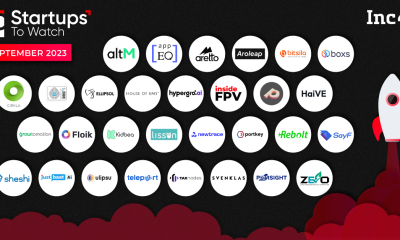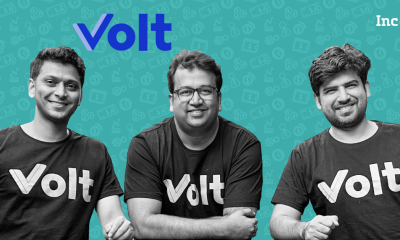Vijay Janapa Reddi runs a lab at Harvard University where he and his team attempt to solve some of the computer world’s greatest challenges. As a specialist in artificial intelligence systems, the technology he studies even follows him home, where his two daughters love to talk to their Amazon Alexa.
Science
The secret environmental cost hiding inside your smart home device

“They put a person inside that black box,” Janapa Reddi likes to joke with his four-year-old.
Janapa Reddi may be teasing when he tells his daughter a person is squeezed into their machine, but isn’t that where we’re headed? Smart home devices may never host a miniature human being inside of them — this isn’t that one episode of Black Mirror — but as the AI ecosystem evolves, voice assistants will quickly begin to feel hyperrealistic. Indeed, tech companies like Amazon are now attempting to integrate large language models like OpenAI’s ChatGPT into smart home devices to elevate user interaction.
“These devices are finally coming a step closer to how we naturally interact with the world around us,” Janapa Reddi said. “That’s a pretty transformative experience.”
“These devices are finally coming a step closer to how we naturally interact with the world around us”
But a machine can’t behave like a human without a cost. All that intelligence requires massive amounts of data — and the computers storing that data require loads of energy. At the moment, over 60 percent of the world’s electricity generation comes from fossil fuels, the main contributor to climate change. A study published in the journal Joule in October found that widespread integration of generative AI could spike energy demands. In one worst-case scenario from the analysis, the technology could consume as much energy as the entire country of Ireland.
Climate change is already exacerbating heatwaves. Last summer was the hottest on record. To make matters worse, the climate crisis has increased the scarcity of water, which some data centers need to stay cool. In order to keep a bad situation from getting worse, scientists have been urging world leaders to stop using fossil fuels. Some advocates, on the other hand, have demanded Congress take action on the energy burdens the AI sector presents.
These concerns link two of society’s most seemingly apocalyptic scenarios: world-dominating AI and world-ending climate change. Are smarter (and more energy-intensive) smart homes really worth the trouble?
Janapa Reddi uses his Amazon Alexa to listen to the news or music. His youngest daughter, on the other hand, often asks Alexa to play “The Poo-Poo Song,” her current obsession. Indeed, there’s something satisfying about coming home after a long day to find your lights dimmed and temperate set just how you like. Smart homes are kind of magical in this way: they learn a user’s behaviors and needs.
The computers storing that data require loads of energy
Though AI has become a buzzword this year with the rise of ChatGPT, it’s been in the background for many years. The AI most people know about and interact with — including in their smart homes — has been around for about 10 years. It’s called machine learning or deep learning. Developers write programs that teach voice assistants what to say when someone asks them for the time or a recipe, for instance.
Smart homes are capable of doing an impressive amount of work, but the technology behind them isn’t as complex as, say, GPT. Alexa gives the same answer to pretty much everyone, and that’s because it’s preprogrammed to do so. The machine’s limited responses, which are processed locally in a person’s home, keep its energy demands quite low.
“The current type of AI that is in these systems are pretty simplistic in that they don’t take in a lot of factors when making decisions,” said William Yeoh, an associate professor of science and engineering at Washington University in St. Louis.
GPT, on the other hand, generates original responses to every query. It considers many factors when it’s deciding how to respond to a user. How was the prompt worded? Was it a command or a question? Is the question open-ended or factual? Generative AI is fed immense amounts of data — trillions of different data points — to learn how to interpret questions with such intelligence and then generate unique responses.
“You never tell [the system] that these are things people might ask because there’s an infinite number of questions people could ask,” said Alex Capecelatro, CEO of AI company Josh.ai, which has built a generative AI smart home system. “Because the system is trained on all of this knowledge… the information is able to be retrieved in pretty much real-time.”
What if this type of deep learning were applied to smart homes? That’s what Capecelatro sought to do back in 2015 when he and his team began to develop JoshGPT, a smart home device doing exactly that. The product remains in development, but the company believes JoshGPT is “the first generative AI to be released in the smart home space.” The technology has processed millions of commands during the six months JoshGPT has been live. Capecelatro is hoping to expand to an international market by early 2024.
For him, this sort of integration is the future: “The old AIs are kind of like a vending machine. You get to pick from the options that exist, but those are the only options. The new world is like having the world’s smartest and most capable chef who can make whatever you ask.”
Are smarter (and more energy-intensive) smart homes really worth the trouble?
Josh.ai isn’t the only company investing in a new smart home ecosystem. In September, Amazon previewed the new iteration of Alexa: one that’s “smarter and more conversational,” per the company’s announcement. Its technology will assess more than verbal directions; it will even follow a user’s body language to offer the perfect response. Meanwhile, Google announced in October new generative AI capabilities that will help users write grocery lists or captions for social media posts. So far, Google hasn’t released plans to add this upgrade to smart home speakers, but it feels like a natural progression.
Smart home proponents like Capecelatro believe the technology can cut a household’s carbon footprint by automating tasks that can reduce energy — like lowering the blinds to keep a room cool or raising them to add natural light. Buildings contribute to over a third of global greenhouse gas emissions. One report from research firm Transforma Insights found that connecting buildings to smart home technologies could reduce global energy consumption by about 5 percent.
Suruchi Dhingra, research manager at Transforma Insights, spoke enthusiastically at length about smart blinds, smart lighting, and smart HVAC systems, shedding light on the energy savings they offer. But when asked about generative AI smart home integration, Dhingra looked confused: “Is there actually a need?”
It’s an important question to ask considering how much more energy goes into training and running AI models like GPT compared to current smart home models. Current energy emissions from these devices would be “significantly smaller” than ones featuring generative AI, Yeoh said. “Just because the number of factors or variables are so much smaller,” he said. Every user command or query would require more computational resources if plugged into a generative AI model. The machine wouldn’t be reciting a response a human programmed; it would be generating an original response after sorting through all the data it’s learned. Plus, smart homes with such advanced technology would need a strong security system to keep intruders from breaking in. That requires energy, too.
“The new world is like having the world’s smartest and most capable chef who can make whatever you ask.”
It’s hard to know whether the potential emissions reductions from smart home capabilities would outweigh the emissions that would come from adding generative AI to the mix. Different experts have different opinions, and none interviewed were comfortable speculating. Like Dhingra, all wondered whether generative AI in smart homes is necessary — but haven’t convenience and ease always been the point? Did we ever actually need to ask a machine for the weather when our phones can already tell us? We had manual dimmer switches before we had smart lights.
However, industry folks like Capecelatro want to see these generative AI models run as efficiently as possible so they can cut costs.
“I’m actually pretty confident we’re going to see a really good trend toward lower and lower emissions needed to generate these AI results,” he said. “Ultimately, everyone wants to be able to do this for less money.”
In October, Alex de Vries published a paper to examine the potential energy demand of AI. The founder of digital trends research company Digiconomist tried to forecast one scenario in particular where Google integrates generative AI into every search. Such functionality would be similar to how a Google Home generative AI integration would work even though de Vries wasn’t examining smart homes.
The study’s worst-case scenario painted a future where Google AI would need as much energy in a year as the entire country of Ireland — but that’s not what he wants the public to take away from the research. “This is a topic that deserves some attention,” de Vries said. “There’s a very realistic pathway for AI to become a serious electricity consumer in the coming years.”
He’s especially critical of the widespread application of generative AI. “One thing you certainly want to avoid is forcing this type of technology on all kinds of applications where it’s not even making sense to make use of AI,” he said.
When asked about generative AI smart home integration, Dhingra looked confused: “Is there actually a need?”
His paper sheds light on the potential emissions that can come from running these huge models — not only from training them, which has historically been a source of energy consumption. De Vries argues that operating these technologies may be driving more emissions now with the deployment of ChatGPT, which saw 100 million users just months after launching. With AI being used in this way, the emissions can grow even higher when you consider that the models need to be retrained every few years to ensure they stay up to date, he said.
That’s why many computer engineers are working on efficiency. What de Vries worries about is that more companies will use generative AI as the technology grows more efficient, keeping energy demands high. “It’s become a guiding principle of environmental economics that increasing efficiency doesn’t necessarily translate to less use of resources — it’s often quite the opposite,” said de Vries, who is also a PhD candidate at the Vrije Universiteit Amsterdam School of Business and Economics. “I don’t think that there is going to be one single thing that is going to solve all our problems.”
Not everyone is as pessimistic. Peter Henderson, an incoming computer science and public affairs professor at Princeton University, is impressed with the efficiency gains AI has seen, especially with the ability of hardware to run programs more locally, which requires less energy. He imagines that if smart homes were to integrate generative AI, they’d default to whatever mechanism is most efficient. Indeed, that’s how JoshGPT is being built: its model splits queries based on whether a command can go through the local processor or requires a full GPT response.
“All in all, the power required for what we are doing is far less than what would be needed to do routine Google searches or streaming Netflix content on a mobile device,” said Capecelatro of Josh.ai.
So much of this, however, is speculative because there’s little transparency around where companies like OpenAI are sourcing their energy. Is coal powering their data centers or hydro? Buying energy from clean sources would alleviate many of the environmental concerns, but there’s only so much energy the Sun or wind can generate. And there’s only so much we can allocate to computers when there are still people without access to electricity or the internet.
“I’m actually pretty confident we’re going to see a really good trend toward lower and lower emissions needed to generate these AI results.”
Without more data, Henderson isn’t sure what to expect for the future of AI. The situation could be better than it seems — or it could be much worse. He’s hopeful about what AI could mean as a tool to combat climate change by optimizing energy grids or developing nuclear fusion, but there are too many questions about the generative AI we may see in our homes one day.
For Janapa Reddi, the questions run much deeper than environmental costs. “What does this all mean in terms of educating the next generation?” he asked. This thought process is why he teases his four-year-old that there’s a person inside their Alexa; he wants his daughter to treat the technology with empathy so that she develops manners she can practice with actual people. Now, his daughter is nicer to Alexa, using words like “please.”
“These are very simple things — but important,” Janapa Reddi said. “They’re going to be using these devices day in, day out, left and right, up and down.”
Underlying all of these conversations and questions is an overall desire to build a better world. For some, “better” entails more convenience and comfort. For others, it’s less reliance on these flashy new technologies. What everyone can agree on, however, is the longing for a healthy world to exist at all.
Science
Summer blackouts are increasing in the US

It’s a trend that raises health risks as the planet heats up. Climate change supercharges disasters like storms and wildfires that often cut off power. Soaring demand for air conditioning also stresses out the grid. All of this can leave people without life-saving cooling or electric medical devices at times when they’re most vulnerable.
Climate Central collected data from the Department of Energy on outages that took place between 2000 and 2023. It looked specifically at periods between May and September each year, warmer months when people rely on air conditioning the most. The analysis focused on blackouts attributed to bad weather or wildfires, which hot and dry conditions can exacerbate.
The findings fall in line with other surveys of power outages over time in the US. Americans experienced an average of 5.5 hours of electricity interruptions in 2022 compared to roughly 3.5 hours in 2013, according to the US Energy Information Administration (EIA). That includes all kinds of power disruptions throughout the year. But the culprit behind longer outages is “major events,” including weather disasters. Without those big events, the length of outages would have mostly flatlined over the past decade.
Certain areas have fared worse than others over the years, the Climate Central analysis shows. The South experienced more weather-related blackouts than any other region during warmer months, with 175 outages between 2000 and 2023. Texas leads the nation as the state with the most weather-related outages, with 107 over the same period.
The nation’s aging grid infrastructure could certainly use an upgrade to make it more resilient to a changing climate. Burying power lines can safeguard them from extreme weather in some scenarios. Residential solar energy systems and microgrids can help keep the lights on for homes even if power plants or power lines go down in a disaster. And switching from fossil fuels to renewable energy would prevent those climate-related disasters from growing into bigger monsters in the first place.
Science
Running on water: hydrogen fuel cells are coming to boats and trucks

Twenty years ago, it seemed like hydrogen fuel cell vehicles would have a bright future.
The cars were cool — luxury sedans with sleek interiors and futuristic-looking touchscreens. They were environmentally friendly, with water vapor as their only byproduct. Regulators were on board, promising big investments for the fueling infrastructure. A bet on the most abundant element in the universe in the fight against air pollution, and eventually climate change, seemed like a sure thing.
But despite tens of thousands of vehicles sold and billions of dollars spent on fueling, that bet has yet to pay off. California remains the only state in the country with any sort of hydrogen fueling infrastructure, with fewer than 50 stations currently in operation. Vehicle sales have essentially collapsed: only 322 fuel cell vehicles were sold in the first half of 2024, 82 percent lower than a year ago.
The fueling infrastructure also seems on the brink of collapse. Stations are shutting down, and the ones that are still in operation are routinely offline due to tech problems and fuel shortages. The price of hydrogen continues to climb, as production problems and supply shortages roil the market.
Tesla CEO Elon Musk called hydrogen fuel cell vehicles “mind-bogglingly stupid”
Critics have panned hydrogen as an inefficient and illogical way to decarbonize transportation. After all, battery-electric vehicles already exist. Tesla CEO Elon Musk called hydrogen fuel cell vehicles “mind-bogglingly stupid.”
But hydrogen still has the potential to be a game changer in the fight against climate change, if we can find a better solution. Despite their early failures, major companies are still pouring billions of dollars into the technology. Governments are drawing up infrastructure plans and passing tax credits in the hopes that they can provide a helping hand.
If hydrogen fuel cells are to hang on, it’s time to think bigger.
Out to sea
The boat bobbing in the waters near Wall Street doesn’t look like the other vessels that typically populate New York’s congested waterways. For one, it isn’t belching diesel smoke like all the shipping containers, oil tankers, and garbage barges. Actually, it isn’t emitting any pollution at all.
The ship, named the Energy Observer, is a sleek, 100-foot-long former French racing catamaran retrofitted with solar panels, slowing sipping sunlight to send to the four lithium-ion batteries sitting below deck. The panels cover almost the entire surface of the boat, so you either have to wear special cloth booties to come on board — or just go barefoot.
On an overcast day last April, it had just completed a seven-year voyage around the world, visiting numerous countries to preach the gospel of renewable energy. Energy Observer is basically a floating laboratory, where its six-person crew can conduct experiments on sustainable energy in order to prove how it can be used to power all types of vessels.
The boat produces all the energy it needs to sail, and it does that through three different methods. The first is solar, through the aforementioned panels. The second is wind power, which is generated through these massive twin masts that look like two airfoils standing straight up. The crew calls these “Ocean Wings,” and they make about 30 percent of the boat’s propulsion power and can move the boat up to 12 knots without impacting its electricity consumption.
The third is hydrogen, which works like this: Seawater is filtered through the hulls to be desalinated and purified before an electrolyzer splits H20 into hydrogen and oxygen. The hydrogen is then converted into electricity courtesy of a Toyota fuel cell, a similar version of the technology that is used in the automaker’s hydrogen-powered sedans, which emit water vapor instead of carbon pollution.
The hydrogen is then converted into electricity courtesy of a Toyota fuel cell
“That’s really the purpose of the ship,” said George Conty, the ship’s affably Swiss boatswain, “producing hydrogen from a mix of renewable energies.”
The Energy Observer isn’t very fast, maxing out at around 11 knots, which is much slower than a typical catamaran. Its racing days are long gone, which makes sense because speed isn’t the ship’s ultimate mission. It’s a demonstration project to prove that hydrogen from renewable sources can be a viable alternative to diesel and other polluting fuels used in maritime.
Shipping accounts for about 3 percent of greenhouse gasses, similar to flying. Transportation on the whole represents over a quarter of all planet-warming emissions. Decarbonizing the sector will be a monumental challenge, and lithium-ion batteries can’t do it alone.
Energy Observer’s team isn’t just banking on a 100-foot-long catamaran to prove its point. A successor, a massive cargo ship called the Energy Observer 2, is still just in the planning phases. And if the companies backing the project can raise enough money to fund its creation — and that’s a big if — it has the potential to demonstrate that liquid hydrogen deserves to be discussed alongside other less carbon-intensive alternatives like biofuels, ammonia, and natural gas.
The Energy Observer 2 will be able to transport 1,100 20-foot-long shipping containers over a distance of 1,800 nautical miles
Once built, the Energy Observer 2 will be able to transport 1,100 20-foot-long shipping containers over a distance of 1,800 nautical miles — not enough for a trans-Atlantic crossing, but enough for intercontinental trips. Like its predecessor, the cargo ship will also run on hydrogen fuel cells provided by car companies like Toyota — just a lot more of them. Over 100 fuel cells, using over 40 tons of liquid hydrogen, generating approximately 4.8 megawatts of power.
“No project in the world has this power,” Victorien Erussard, the ship’s captain, told me. But his venture is already running into familiar problems around cost and refueling infrastructure. It’s not going to be an easy transition. It will require more investors, more supporters, and more true believers in hydrogen to make this work.
“Many, many, many more boats,” Erussard said.
Truck stuff
But also trucks — which General Motors knows a thing or two about. Especially the leviathan-sized ones that are big enough to handle the heaviest loads.
GM was one of the first automakers to stick a hydrogen fuel cell into a vehicle. The company’s 1966 Electrovan, a converted GMC Handi-Bus with hydrogen-oxygen power, could reportedly do 70mph and travel 150 miles.
Today, the company’s fuel cell-powered vehicles look a little different. GM’s Hydrotec division is investing in heavy-duty trucks — think mining equipment, cement mixers, and terminal tractors — as well as a few medium-duty ones. The idea is to use hydrogen to decarbonize heavy industries, which is ill-suited for battery-electric vehicles that are slow to charge.
Even hydrogen’s profound fueling shortcomings could be easily fixed. Heavy-duty trucks typically operate in confined spaces, like construction sites, warehouses, ports, and quarries. Under those circumstances, fueling stations can be centrally located to service a whole fleet of hydrogen fuel cell vehicles. No need for a hydrogen fueling station on every residential street corner.
GM was one of the first automakers to stick a hydrogen fuel cell into a vehicle
It’s still “early days,” Hydrotec’s executive director, Charlie Freese, tells me. GM is still testing its technology to see what works and what won’t. In addition to the trucks, there’s also the fuel cells themselves, bundled together into a cube-shaped package, befittingly called Power Cubes. These cubes, developed alongside Honda, can be used to power several different vehicles. They can even be used for stationary power generators for outdoor events, replacing all those dirty diesel generators used today.
Other automakers, like Toyota, rushed too quickly into the passenger vehicle market before the fueling infrastructure was in place, Freese said. The Toyota Mirai, the first mainstream fuel cell vehicle that was first introduced in 2014, may have been a ground-breaking vehicle at the time, but now it’s an albatross for many of the owners.
“It was clear that that wouldn’t be a very rewarding experience,” Freese said. “The technology really lends itself best to the heaviest vehicles, the ones that carry heavy payloads, travel the longest distances, and need very fast refueling.”
GM has not released a fuel cell vehicle for the consumer market, but its joint venture with Honda just started mass-producing fuel cells at its Michigan plant earlier this year. And a medium-duty truck, based on the Chevy Silverado 5500, is on the way. GM thinks it could be the ideal work truck for farmers.
“It’s not going to be perfect right at the immediate outset,” Freese admitted. Most hydrogen in the US is what’s called “gray hydrogen,” meaning it is produced through a process called steam methane reforming, which emits greenhouse gases. The hope is to eventually switch to “green hydrogen,” made by renewable energy sources like solar and wind. But we’re not there yet.
“If I’m using a hydrogen fuel cell, I’m greening my fleet, even if it’s gray hydrogen,” Freese said. “And over time, the gray hydrogen can be replaced with green hydrogen. But that takes more of a build-out of the infrastructure… they got to grow together.”
Allen J. Schaben / Los Angeles Times via Getty Images
Fueling failures
Jacob Brouwer was one of those early adopters of hydrogen. He drove a Toyota Mirai for over seven years, attracted to its smooth acceleration, boastful range, and luxury interior. The $15,000 prepaid fueling card from Toyota didn’t hurt, either.
But these days, he drives a Tesla. It doesn’t reflect well on hydrogen when the director of UC Irvine’s Clean Energy Institute has decided that a car made by Elon Musk is preferable to one that runs on fuel cells. He blames California’s energy regulators for fumbling the rollout, failing to get to the promised 200 stations and leaving the project incomplete.
“We just didn’t fulfill the plan,” Brouwer says. “I feel very bad for the Mirai owners.”
“I feel very bad for the Mirai owners.”
But despite his firsthand experience with the shortcomings, he’s less pessimistic than most when it comes to the future of hydrogen. In addition to boats and heavy trucks, he sees numerous applications as being perfect for fuel cell technology, including tractors, buses, freight, trains, light-duty hybrid vehicles, and even aviation.
Indeed, there have been some compelling experiments in fuel cell-powered flight. Joby Aviation is developing a hydrogen-powered version of its vertical takeoff and landing aircraft for longer trips between cities. And American Airlines recently agreed to buy 100 hydrogen-electric engines from ZeroAvia, a fuel cell aviation startup, to power its regional jets.
Aviation is especially difficult to decarbonize; aircraft need to be just light enough to achieve flight, and heavy lithium-ion batteries would screw up that ratio. Hydrogen is practically feathery in comparison.
There are uses for hydrogen even beyond transportation, Brouwer said. Cement and steel comprise about 12 percent of greenhouse gas emissions. Hydrogen is better suited to decarbonize cement and steel production than batteries. Data centers housing servers powering the AI boom — you could run those with hydrogen, too. The list goes on.
But for an element as abundant as hydrogen, it can be maddeningly hard to find.
“Electricity is available everywhere, but hydrogen isn’t”
For all of these applications to become a reality, to become more than just glorified experiments like the Energy Observer or GM’s Power Cubes, they need the fueling infrastructure to rise up, too. Battery-electric vehicles never quite had it this bad. Sure, the public charging experience for EVs leaves a lot to be desired. But electricity has a big head start.
“Electricity goes to every business,” Brouwer said. “Electricity is available everywhere, but hydrogen isn’t.”
He thinks it can get there. The Biden administration is all in on hydrogen, approving tax credits to support the production of green hydrogen and doling out $7 billion for regional production hubs across the US. Things still look grim for the average Toyota Mirai owner, but the clouds seem to be clearing for everything that’s not a light-duty vehicle.
“We are at the beginning of the beginning,” Brouwer said. It’s a strange way to think about a technology that is decades, if not centuries, old. But it’s finally looking as if hydrogen is ready to pull its own weight.
Science
Lost Highway


In 2004, California Governor Arnold Schwarzenegger announced plans for a “hydrogen highway.” It called for a new kind of fuel station, built to support a new kind of electric vehicle. Cars powered by hydrogen fuel cells could help clean up the air and free the US from foreign oil — and California could lead the way.
That’s not what happened. Twenty years later, the American auto industry is shifting overwhelmingly to electric vehicles… but they run on batteries, not hydrogen. The hydrogen highway is littered with shortages, high prices, and faulty equipment. Thousands of drivers across the state are left wondering whether they bet on the wrong future.
We wanted to find out what happened to California’s hydrogen dream.
So, we hit the road.
Our mission: a roughly 450-mile trip across California in a Toyota Mirai, the most popular hydrogen-powered car on the market today. We planned to drive around the Bay Area, down through Central California, and into Los Angeles, visiting as many stations and meeting as many drivers as possible along the way.
Bay Area
Milpitas
We rented a Mirai on Turo — it was one of only two available hydrogen-powered cars on the platform in the Bay Area. The car’s owner, Salman, told us he was concerned about our itinerary.
Cupertino
Manideep and Rupesh were the first fuel cell drivers we met. They’ve been driving their Mirai for about four months, and while they love the car, the fuel situation is wearing on them. They also had some advice for our road trip.
Sunnyvale
All the hydrogen pumps we saw were co-located at traditional gas stations; the hydrogen distributor leases the space from station owners. At some stations, hydrogen pumps were sandwiched between gas pumps.
Palo Alto
One pump we visited in Palo Alto has been offline for two years. The pump’s operator, FirstElement Fuel, told us that it took the pump over from a different hydrogen supplier but that systems issues have prevented it from bringing the station online.
South San Francisco
Earlier this year, Shell closed nearly all of its hydrogen stations across the state; there are no longer any active stations in the city of San Francisco. It’s put additional strain on the remaining Bay Area stations.
Oakland
Another Mirai driver we met, Rebecca, was committed to her car and more optimistic about the future of hydrogen.
San Jose
We needed to top off the tank before leaving the Bay Area. The final station we visited was online — but actually getting fuel was another story.
Along the I-5 corridor between San Francisco and Los Angeles, there are hundreds of battery EV charging plugs — and one hydrogen pump. It’s at a place called Harris Ranch, a rest stop deep in California’s Central Valley. Since our Mirai wasn’t likely to make it all the way to SoCal on one tank, we stopped at Harris Ranch to refuel and see whether other hydrogen road trippers showed up.
Harris Ranch
Harris Ranch Resort
The Harris Ranch Resort is massive. In addition to a Shell gas station, Tesla Superchargers, and a hydrogen pump, it also boasts a Spanish hacienda-style hotel, multiple restaurants, and a gift shop with its own butcher counter.
Tesla Supercharger
The Harris Ranch Supercharger station is reportedly the largest bank of chargers ever built by Tesla. While waiting for hydrogen cars to show up, we wandered over and asked Tesla drivers about life with their battery-electric cars.
James Sweet Bonsai
James Kim has been selling bonsai trees for 23 years. His van is parked just across the street from the exit to Harris Ranch, and he says he gets customers from all over. His largest trees are more than 30 years old.
Hydrogen Fuel Station
After four hours of waiting, another Mirai finally showed up. Billy Chen has made the trip between LA and San Francisco several times — he’s the only driver we found who has.
Since September of 2023, 13 hydrogen stations in the Los Angeles area have been largely offline due to problems with a regional fuel supplier. The shortage has been a major headache for fuel cell drivers in LA — and there are more here than anywhere else in the state.
Los Angeles
San Fernando
The first station we reached in Southern California had four fuel pumps and was unaffected by the hydrogen shortage. Unsurprisingly, it was the busiest station we visited.
Sherman Oaks
There’s a concentration of hydrogen-powered cars here in LA, but the ecosystem is still exceptionally niche. In the first half of 2024, about 322 fuel cell cars were sold in California. At many stations, Mirai sightings were rare.
Burbank
We heard a similar story from lots of drivers: they were considering a battery-electric car but were talked into a Mirai. Many regretted the choice.
Studio City
Like in the Bay Area, there are very few stations in Southern California outside of Greater Los Angeles. So, road trips farther afield are risky.
Hollywood
As of publication, there is no estimate for when the hydrogen supply shortage in Southern California will be resolved, leaving stations like this one offline indefinitely. The shortage will hit the one-year mark in September.
Even if California’s hydrogen highway falls apart, fuel cell technology may still find its niche in a decarbonizing world. The Verge’s Andrew Hawkins dove into the world of hydrogen-powered trucks, boats, planes, and a lot more.
-

 Startup Stories11 months ago
Startup Stories11 months agoWhy Millennials, GenZs Are Riding The Investment Tech Wave In India
-

 Startup Stories11 months ago
Startup Stories11 months agoStartups That Caught Our Eyes In September 2023
-

 Startup Stories11 months ago
Startup Stories11 months agoHow Raaho Is Using Tech To Transform India’s Fragmented Commercial Trucking
-

 Startup Stories10 months ago
Startup Stories10 months agoMeet The 10 Indian Startup Gems In The Indian Jewellery Industry’s Crown
-

 Crptocurrency6 months ago
Crptocurrency6 months agoLither is Making Crypto Safe, Fun, and Profitable for Everyone!
-

 Startup Stories11 months ago
Startup Stories11 months agoHow Volt Money Is Unlocking The Value Of Mutual Funds With Secured Lending
-

 E-commerce11 months ago
E-commerce11 months agoTop Online Couponing Trends To Watch Out For In 2016
-

 Startup Stories11 months ago
Startup Stories11 months agoWhy Moscow-Based Kladana Considers Indian SME Sector As The Next Big Market For Cloud Computing




